The Asylum for Fatherless Children / Reedham Orphanage, Purley, Surrey
The Asylum for Fatherless Children (later known as the Reedham Orphanage) was founded in 1844 by the Reverend (later Sir) Andrew Reed (1787-1862). Reed was a minister in the Congregational church and a prolific philanthropist, with the London Orphan Asylum (1813), the Wanstead Infant Orphan Asylum (1827), the Earlswood Asylum for Idiots (1847) and the Royal Hospital for Incurables (1854) also owing their existence to his efforts. Reed was particularly effective at raising money for his schemes from the wealthy and prestigious such as royalty and City merchants.

Andrew Reed
Reed always believed that philanthropy should be non-denominational and the Asylum for Fatherless Children was set up in response to the governors of his Infant Orphan Asylum insistence on Church of England catechisms being used there.
His new Asylum aimed to relieve fatherless children without regard to place, sex, or religious distinction, the only qualification being that the child must be destitute, and above the condition of a pauper. Children would be received at any age (from birth, if necessary) and provided for until the age of fourteen for boys, and fifteen for girls.
The home initially occupied a series of temporary premises. The first was a large riverside house at Richmond-on-Thames. As the numbers of children grew it moved to larger premises at Hackney Road, Stoke Newington, then to a large mansion at Stamford Hill in 1846. Ten years later, 135 children were in residence, with 324 having been taken in since the charity's founding in 1844.
Preparations for a large new purpose-built residence began in 1853 with the purchase of a three-acre hillside estate on what in now Old Lodge Lane, Purley, though at that time the location was usually referred to as Coulsdon. The home was named the Reedham Asylum, after its founder, with the same name also being adopted by the village that subsequently grew up roundabout. The new building's foundation stone was laid by the Lord Mayor of London on August 5th, 1856. The construction work was completed two years later.
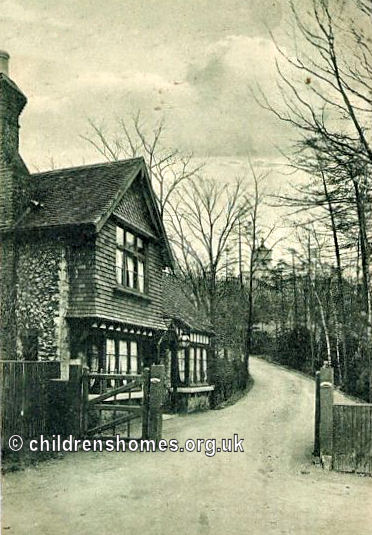
Entrance lodge, Reedham Orphanage, Purley, c.1908.
The three-storey buildings, designed in the Italianate style, adopted a 'double-courtyard' layout. The main frontage faced to the west with boys' and girls' classrooms placed either side. Other facilities such as washrooms and playrooms were in the side wings. The staff quarters and children's dormitories were located on the upper floors. A church, non-denominational in keeping with Reed's principles, was opened to the north of the main building in 1879. The layout of the site is shown on the 1913 map below.
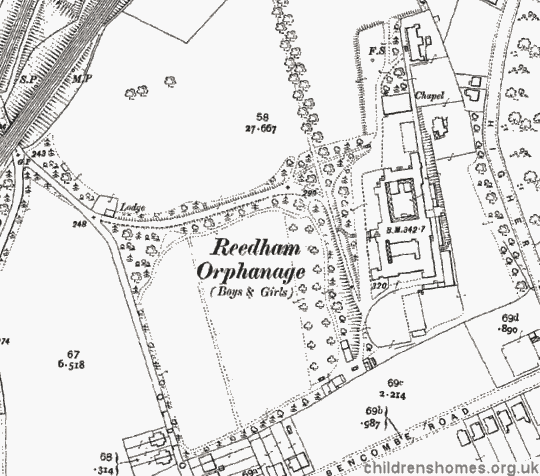
The Reedham Orphanage site, Purley, c.1913.
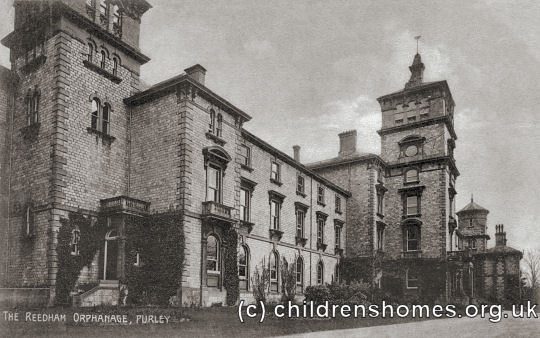
Reedham Orphanage, Purley, from the north-west, c.1908. © Peter Higginbotham
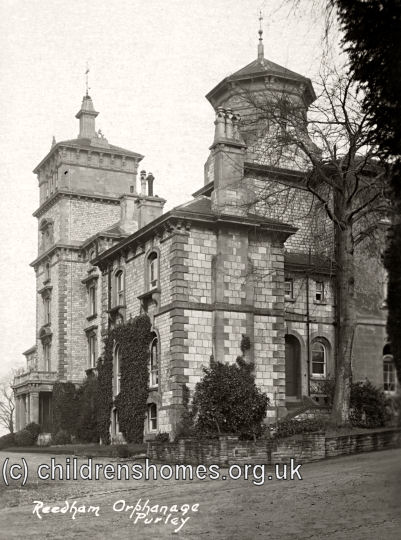
Reedham Orphanage, Purley, from the south-west, c.1908. © Peter Higginbotham
The new building could accommodate 300, with applicants required to be aged between 3 months and 10 years, and whose fathers were dead or were suffering physical or mental disability. As places only became available when an existing resident left the home, competition for free spaces was intense. Up until 1939, admission to the institution was through a twice-yearly ballot of the charity's subscribers who each received a number of votes based on the value of their donation. A minimum number of votes was required to gain admission, although unsuccessful candidates could carry their votes forward votes to the following election. A child could gain advantage if it could obtain the support of one or more wealthy subscribers and much lobbying went on to promote the causes of particular children. Subscribers to the charity, as well as having voting rights regarding applicants, could also endow a bed in their name at the home.
Despite the outward grandeur of the buildings, it was often a different story inside, particularly in the early days. The home's location meant that all its water had to be raised from a well. Candles provided the only lighting, and there was originally no form of heating.
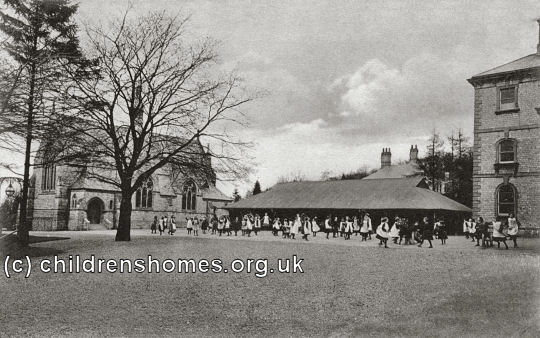
Reedham Orphanage girls' playground, Purley, c.1908. © Peter Higginbotham
Reedham's first Headmaster was John Edmed. He was succeeded in 1879 by James A Carter, H.E. Clarke (1908), L.C. Fairbairn (1938), and Mr F Akehurst (1952) who was the last to hold a post with that title after teaching within the institution was discontinued in the 1960s. In 1967, the post of Principal was instituted, a post successively held by Mr D Knight, Mr Clark, Mr Richardson and Mrs Audrey Boddy.
During James Carter's tenure, the school was divided into 'houses'. Those for the boys were named after notable men: Howard, Livingstone, Wilberforce and Shaftesbury; those the girls after heroic women: Nightingale, Fry and Frances Willard (later renamed Cavell). A Boy Scouts troop was formed in around 1909, with a Girl Guides company following in 1914. A gymnasium was added to the school's facilities at around this time.
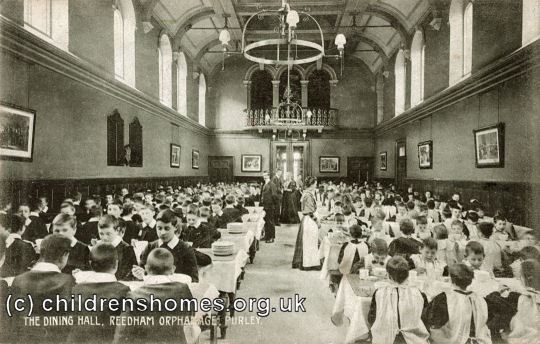
Reedham Orphanage dining hall, Purley, c.1908. © Peter Higginbotham
In 1904, the home was renamed the Reedham Orphanage in 1904, although it also was also referred to locally as the Home on the Hill.
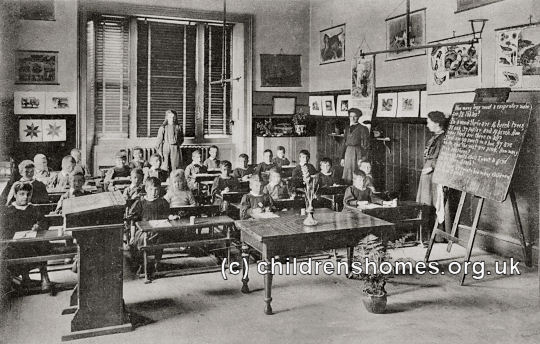
Reedham Orphanage infants' school-room, Purley, c.1908. © Peter Higginbotham
The charity's rules relating to matters such as admission evolved slightly over the years. Here is the charity's entry in a directory from the early 1900s, by which time entrance to the home could be purchased by payment of a lump sum:
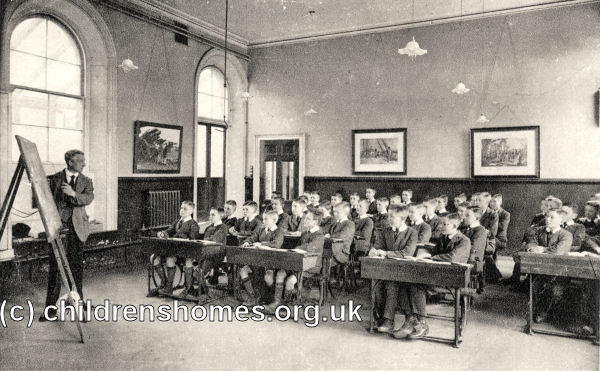
Reedham Orphanage infants' school-room, Purley, date unknown. © Peter Higginbotham
The school continued operating through the First and Second World Wars although in June 1944 the threat of attack by German jet-powered 'doodlebug' bombs led the children to be evacuated to Nottingham for the next twelve months.
The home was again renamed in 1950, now becoming known as Reedham School.
By the mid-1970s, the school was in increasing financial difficulties, with debts of £60,000. It was eventually decided to try and sell the main building while a much reduced home continued operating in the school's former sanatorium. At around this time, a U.S. business consortium approached Reedham's Board with a scheme to turn the property into a school for the children of American families brought to Britain by the North Sea oil boom. However, the venture failed to attract enough applicants to make it viable.
The school finally closed on January 9th, 1980. The sale of the site has funded the work of the Reedham Trust, a charity supporting children whose parents are dead or disabled. The former school buildings have all been demolished with the exception of the old entrance lodge which now houses the Reedham Trust together with a museum of Reedham's history.
Records
Note: many repositories impose a closure period of up to 100 years for records identifying individuals. Before travelling a long distance, always check that the records you want to consult will be available.
- For enquiries about relatives who may have attended Reedham, contact the Historian at Reedham Old Scholars Association via the link on their home page.
- The
Ancestry UK
website has two collections of London workhouse records (both name searchable):
- The Find My Past website has workhouse / poor law records for Westminster.
-
London Metropolitan Archives, 40 Northampton Road, London EC1R OHB.
File: A/FWA/C/D/173/001 — Reedham Orphanage correspondence and papers (1888-1941).
Census
Bibliography
- Rolph, Harry Edward The Home on the Hill (1981, Reedham Old Scholars Association)
Links
Except where indicated, this page () © Peter Higginbotham. Contents may not be reproduced without permission.


